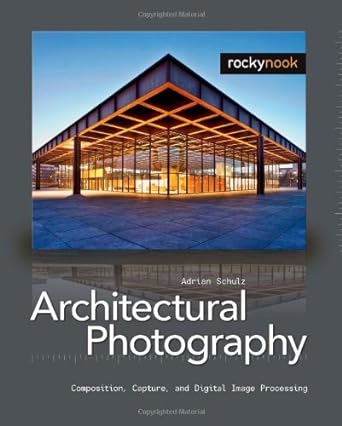Architectural Photography
Composition, Capture, and Digital Image Processing, By Adrian Schulz
Summary

| Content | 7/10 |
| Readability | 7/10 |
| Presentation | 8/10 |
| Ideas | 7/10 |
| Value for money | 7/10 |
| Did it do what it said on the box? | 7/10 |
How do the rankings work?
The Review
A sandwich with not quite enough meat
This is a good, broad introduction to the field of architectural photography which will suit photographers with basic to intermediate skill levels. That said, the level of detail varies, and it will leave some readers wanting more.
After a good general introduction, the second chapter is on photographic technology. This starts with a discussion on analog vs digital photography which rather annoyed me, with its gross over-simplification of digital processing and generalisations on digital camera characteristics, with some confusion between dynamic range and aperture settings. In fairness many of the omissions (such as RAW workflows) are dealt with at length later in the book, but this section sets a simplistic tone which is not representative of the rest. The section proceeds with a reasonably fair comparison of different camera formats, albeit slightly hung up on pixel size, and a good, even-handed discussion and recommendations on lenses and additional equipment, but contains nothing of great value to the reasonably experienced photographer.
The chapter on shooting techniques is the core of the book. This starts with a discussion on the various objectives of architectural photography, and moves on to consider how to extract very different images from the same basic subject. After that the book leads the reader through perspective and its relationship to camera position, and the various ways to correct perspective distortions such as converging verticals. All this is done with clear examples, showing the effects by comparison of two or more shots of the same subject.
The various sections on composition are excellent, with good advice on how to emphasise different aspects, or make an image more inclusive, but I found the section on panoramas a bit basic, with no real advice on how to avoid common stitching distortions. A similar complaint might be levelled at the sections on exposure and shooting interiors, which are very dry and concise, although I can’t find fault with anything which is said. The author does make the positive recommendation of using naturalistic HDR to address extreme dynamic range, and provides good exterior and interior examples, plus a comparitive example of the technique overdone.
A following section on lighting considerations, including shadows, reflections, weather and seasons is short, but has some good recommendations, including how to exploit different conditions for different moods. The chapter then finishes with a short section on photographing buildings creatively, which contains a number of simple yet powerful suggestions.
The third chapter is a slight oddity – a "commentary" by experienced architectural photographer Marcus Bredt. This summarises a lot of the main chapter’s themes, but with a different photographer’s words and examples. In another book this would be the guest forward, but I rather like this "tell them what you have told them" positioning.
The final chapter is on image processing. It starts with quite a detailed discussion on RAW vs JPEG, and a rather mechanical account of setting up a RAW conversion in Adobe Camera Raw. There’s nothing wrong with these, but they feel slightly out of place. A useful but short section on perspective correction is followed by a long worked example of general image adjustment in PhotoShop, which has nothing to do with the book’s main topic. Worked examples on panoramas and HDR are more relevant, but still have too much image-specific blow by blow detail and insufficient discussion of the general issues which arise when applying these techniques to architectural photography.
The book finishes with a short and very basic section on creative adjustments, but there’s no overall conclusion. I was hoping for more detail on things like perspective correction techniques, but that’s missing.
This book is rather like a sandwich with too much boring bread, and a tasty filling which isn’t quite thick enough. The processing section feels like filler, and detracts from the excellent core on composing and shooting architectural photographs. The latter is good enough for me to recommend the book, but I must warn you that some topics will leave you wanting more. This is a good book, but could have been better.
Buy It From Amazon
Amazon.co.uk  |  | Amazon.com
|

 Thoughts on the World (Main Feed)
Thoughts on the World (Main Feed) Main feed (direct XML)
Main feed (direct XML)